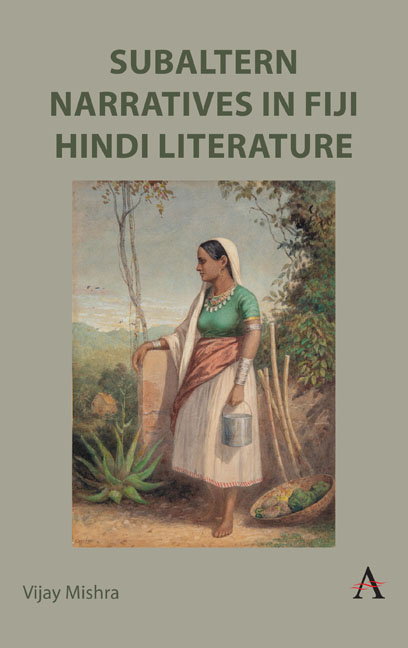Book contents
- Frontmatter
- Dedication
- Contents
- Acknowledgements
- A Note on Transliteration
- Map of Fiji
- Foreword: On the Genesis of Ḍaukā Purān
- Introduction: Reading the Fiji Hindi Demotic
- 1 Introduction: Reading the Fiji Hindi Demotic
- 2 The Moment of Ḍaukā Purān
- 3 Fījī Māṁ: The Female Subaltern Epic
- Conclusion: Can the Subaltern Speak? Language Itself Speaks
- Appendix: Glossary of Fiji Hindi and Fijian Words
- Select Bibliography
- Index
Foreword: On the Genesis of Ḍaukā Purān
Published online by Cambridge University Press: 13 April 2024
- Frontmatter
- Dedication
- Contents
- Acknowledgements
- A Note on Transliteration
- Map of Fiji
- Foreword: On the Genesis of Ḍaukā Purān
- Introduction: Reading the Fiji Hindi Demotic
- 1 Introduction: Reading the Fiji Hindi Demotic
- 2 The Moment of Ḍaukā Purān
- 3 Fījī Māṁ: The Female Subaltern Epic
- Conclusion: Can the Subaltern Speak? Language Itself Speaks
- Appendix: Glossary of Fiji Hindi and Fijian Words
- Select Bibliography
- Index
Summary
Part of the aesthetics, one might even say the romance, of writing a novel in Hindi was, for me, using the Devanāgarī script. At the time I started writing my novel, the Roman script was coming into vogue. A fellow writer, Raymond Pillai, had written a play in Hindi using the Roman script. To me, Hindi in Roman script looked unadorned, robbed of its grace and poetry. If this is how Hindi was to survive, then it seemed an insidious, degraded survival; just a temporary reprieve. The trend had to be resisted.
I had learnt Hindi only up to the secondary school level. My first attempt at writing fiction was in Devanāgarī. I wrote a highly sentimental novel in the style of the popular writers of romance. My teachers rightly dismissed it as trash.
I returned to creating in Hindi after I had established myself as a writer in English, three decades later. What I remembered of the Devanāgarī script had receded to the far corner of my memory. I had to bring it to the fore, and work like a medieval monk, arduously forming each letter and word, re-capturing their curve and swirl, putting them together like a jeweller inserting tiny gems to form an ornament. I sensed the old rhythms returning. Devanāgarī was my link with life that I had left behind. The words fell on the page, looking so unfamiliar, unlike the characters I saw in Hindi textbooks. That did not deter me. At no time did I doubt about the worthiness of the writing project. In fact, I was struck by the originality of what was appearing in front of me. I was confident enough to read the pages, as they emerged in slow increments, to a real scholar of the language – Pandit Vivekanand Sharma. He taught Hindi at the university. He came to my office at the University of the South Pacific every morning, an embroidered shawl thrown over his shoulder, and heard me, Scheherazade, telling a thousand and one tales to a tyrannical Sultan who would behead me if I failed. I was hugely relieved seeing the Sultan chortle, guffaw, and at times breaking into uncontrollable laughter. I was assured that the story would live.
- Type
- Chapter
- Information
- Subaltern Narratives in Fiji Hindi Literature , pp. xv - xxPublisher: Anthem PressPrint publication year: 2024

